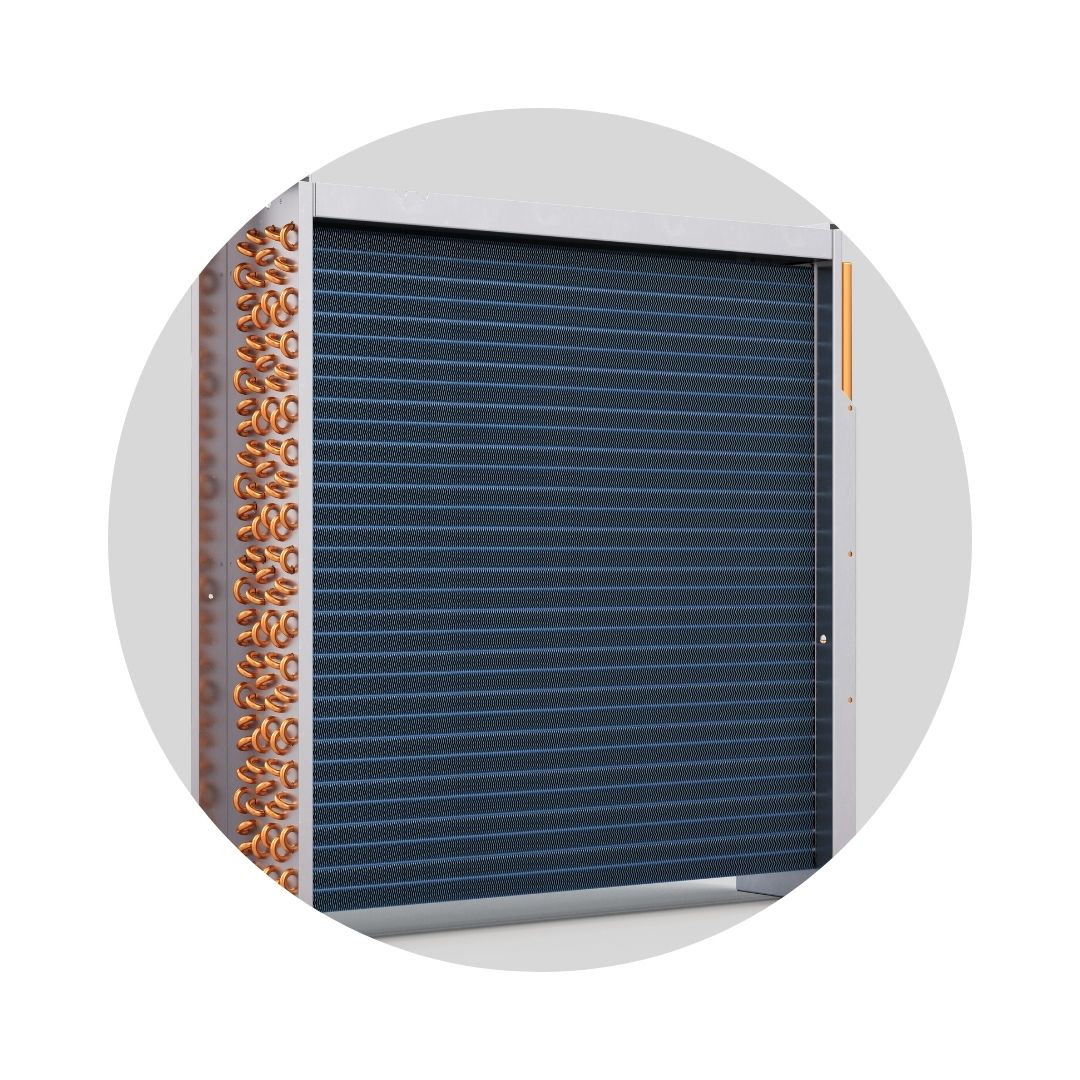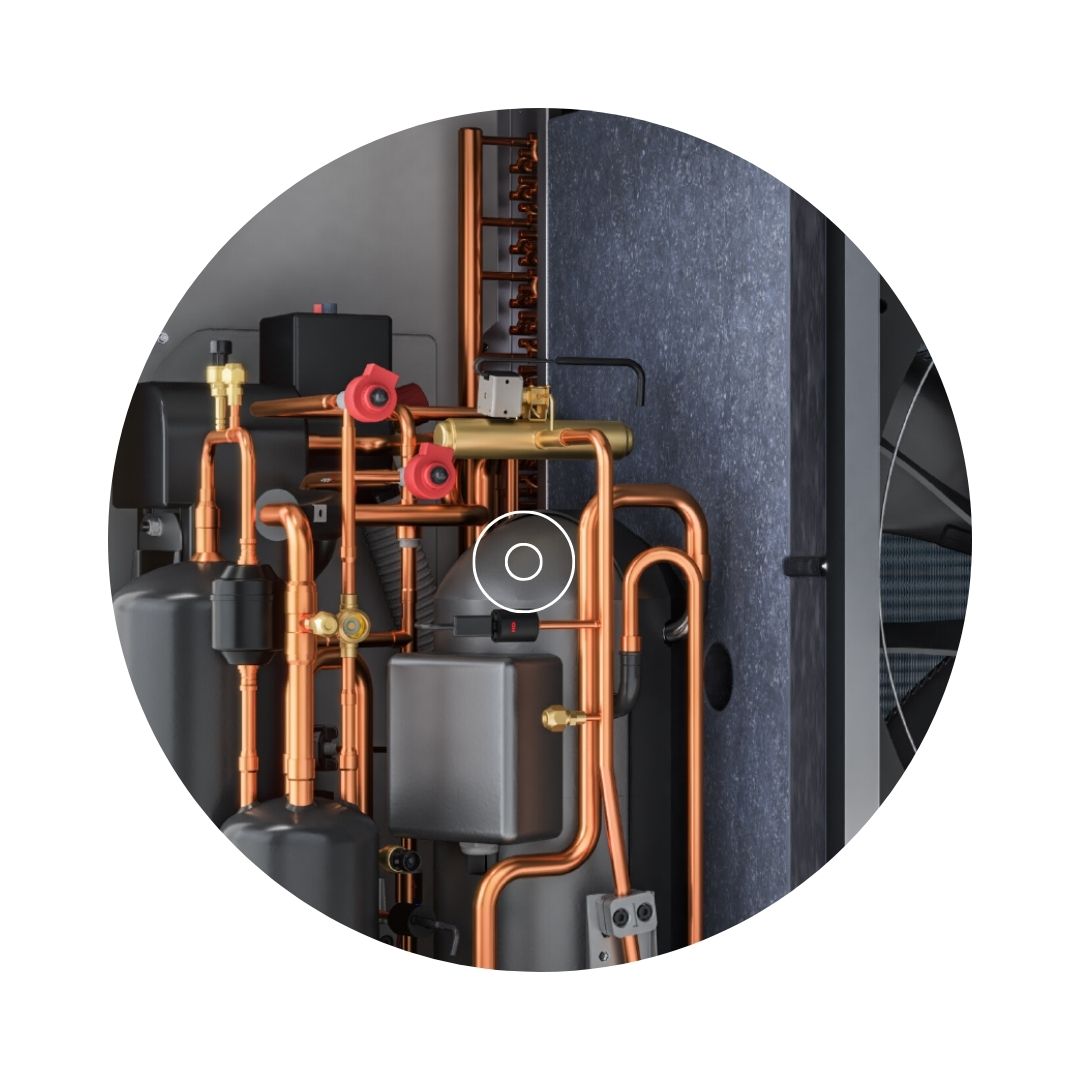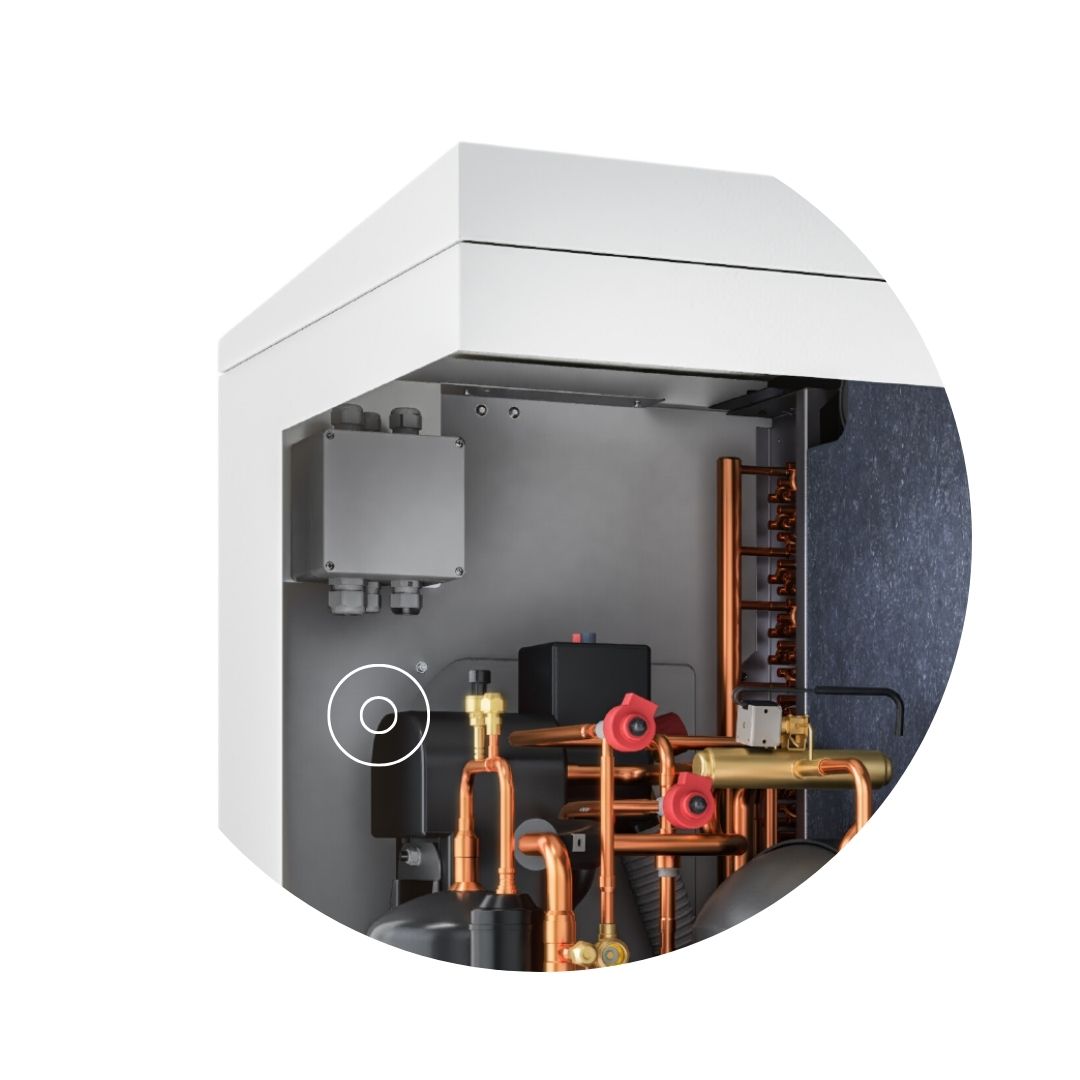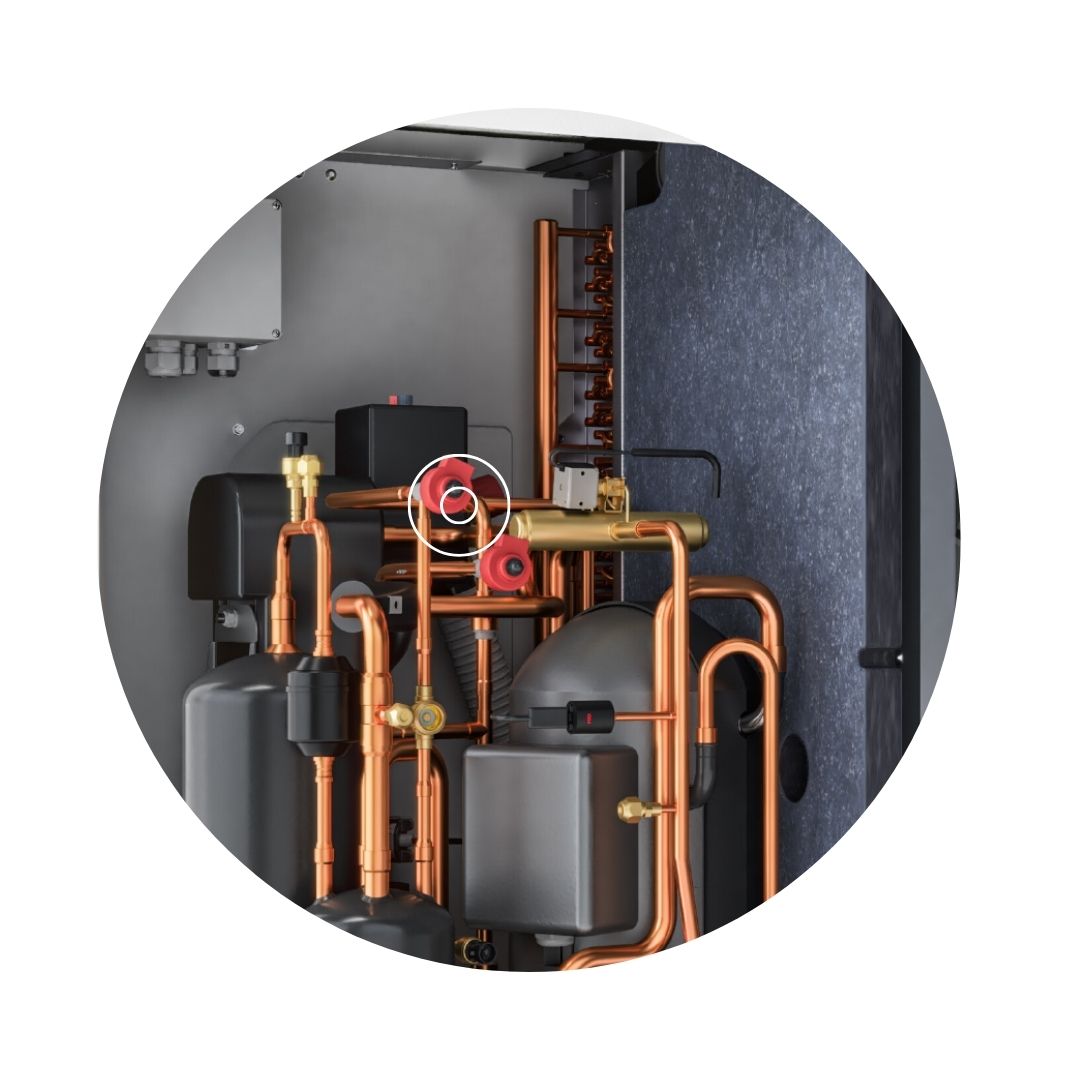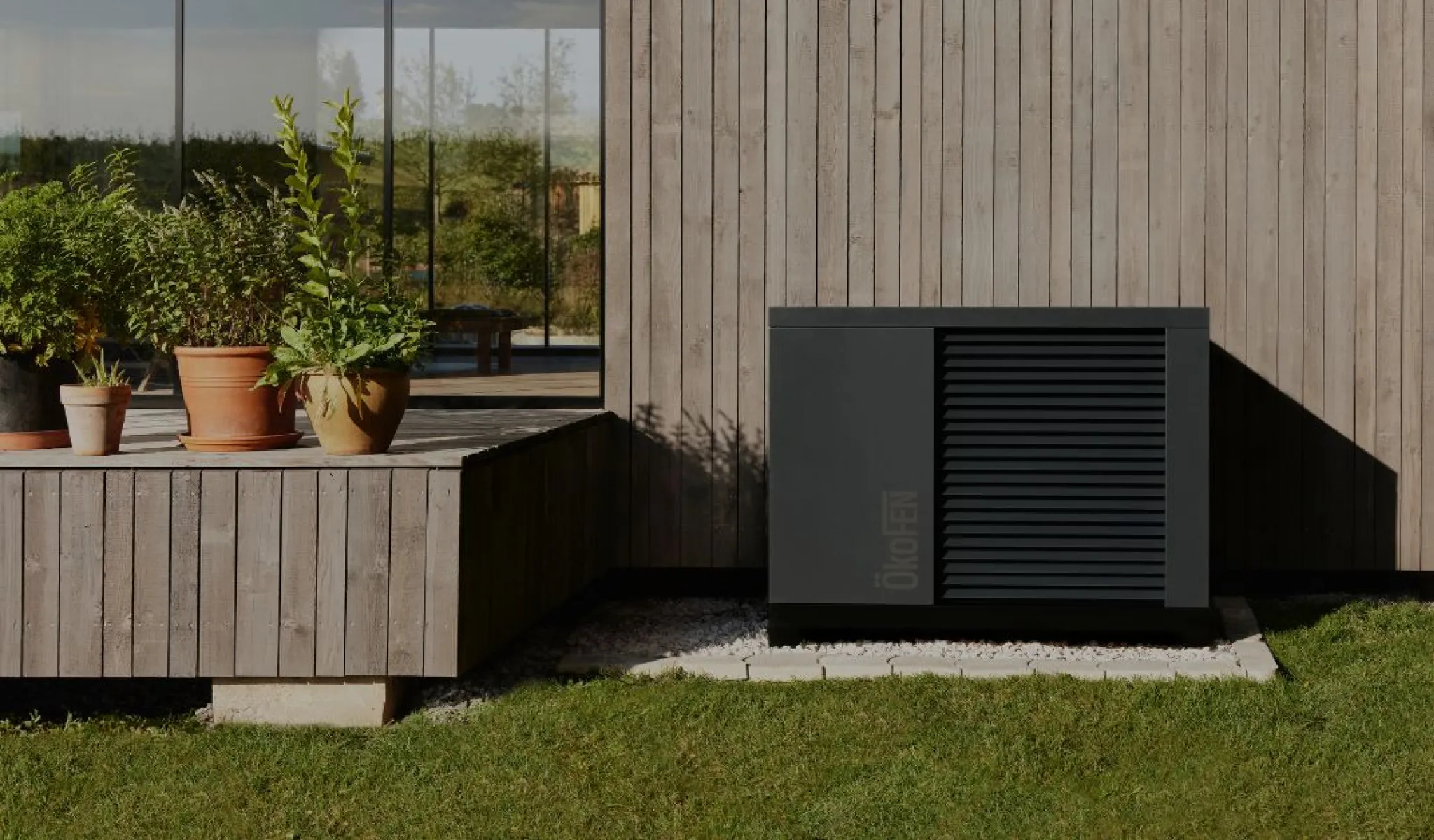
How does a heat pump
actually work?
How a heat pump works - heating explained simply
In a world where sustainability and energy efficiency are becoming increasingly important, it is crucial to understand the technologies that will help us move one step closer to a green future. One of these modern heating technologies is the heat pump. But how does this heating system actually work? How does an air source heat pump manage to convert the ambient air into natural heat for the home? The operating principle of a heat pump, its most important components and details on its operation can be found here.
How energy is created from air:
Depending on the type of heat pump, the heat pump extracts heat energy from the environment - air, groundwater or ground - by passing a refrigerant (in liquid form) through an evaporator. The refrigerant evaporates at a low temperature and absorbs heat from the environment.
The vaporised refrigerant is fed from the evaporator into the compressor. Compression heats the gas considerably and also increases the pressure, which further increases the temperature of the refrigerant.
The hot, compressed gas is then passed through a condenser, where it transfers its heat energy to the heating system (e.g. underfloor heating, radiators). During this process, the refrigerant condenses and returns to its liquid state.
The cooled and liquefied refrigerant is finally passed through an expansion valve, which lowers the pressure of the refrigerant and returns it to the evaporator to start the cycle all over again.

Video: Wie funktioniert eine Wärmepumpe?
The most important components of a heat pump
A heat pump consists of several components that work together to transfer heat energy from a lower temperature level to a higher one.
The refrigerant is the substance that circulates in the heat pump and transfers the heat. It changes its state from gaseous to liquid and vice versa, depending on the pressure and temperature in the various components of the heat pump.
GreenFOX impresses with state-of-the-art technology
The GreenFOX air-to-water heat pumps are manufactured at the company's headquarters and production site in Austria and achieve top efficiency values thanks to innovative technologies and the use of the effective and environmentally friendly refrigerant R290. At the same time, the heating system optimises energy consumption using smart GreenMode control. It also enables low-C02 operation all year round by adapting the heating requirement to the most cost-effective and environmentally friendly heating times.
Refrigerants in air source heat pumps: function and environmental impact
The refrigerant in an air source heat pump is a fluid that has the ability to absorb heat at a cold temperature and low pressure and release it again at a higher temperature and pressure. It serves as a transfer medium for the energy generated in the heating process.
In future, the use of artificial refrigerants such as HFC refrigerants or PFAS, which consist mainly of chemicals, will be restricted for installation in heat pumps due to their environmental impact. For comparison: if such a refrigerant leaks, the effect of just one kilogramme of the liquid is up to two thousand times more harmful than the emission of one kilogramme of CO2.
An environmentally friendly alternative to synthetic refrigerants is the gaseous R290 (propane). It has a low GWP (Global Warming Potential) and is seen as the future of refrigerants in the heat pump sector. The GreenFOX heat pump uses the natural refrigerant R290, which also enables a higher flow temperature of 65 degrees and thus significantly increases the efficiency of the heat pump.
Can heat pumps also cool?
Yes, most heat pumps are also able to cool buildings at high outside temperatures.
Heat pumps can operate in a reverse cycle to remove heat from inside a building and cool it. This process is referred to as ‘reverse operation’ or ‘cooling operation’.
The ability of a heat pump to heat and cool makes it a versatile solution for air conditioning buildings and allows it to provide comfort all year round, regardless of weather conditions. The right hydraulics and installation of the heat pump are crucial for cooling.
Heating & cooling with GreenFOX
Different types of heat pumps
There are various types of heat pumps, which differ mainly in their different heat sources & modes of operation:
Monoblock vs. Splitblock
Monoblock and split-block heat pumps are two different types that differ in their design, functionality, and efficiency.
- In a monoblock heat pump, all key components, such as the evaporator, compressor, and condenser, are housed within a single unit.
- The refrigerant circulates through the evaporator, compressor, and condenser in a closed loop within the unit.
- Monoblock heat pumps are generally compact and easy to install.
- They are well-suited for smaller applications and residential buildings with moderate heating and cooling needs.
- In a split-block heat pump, the evaporator unit (indoors) and the compressor unit (outdoors) are housed in two separate blocks or units.
- The evaporator unit is installed inside the building, while the compressor unit is placed outside.
- The two units are connected by refrigerant lines, allowing the refrigerant to circulate between them.
- Split-block heat pumps often offer higher performance and flexibility in installation, as the outdoor unit can be more easily positioned in different locations.
What factors influence the operation of a heat pump?
Frequently asked questions and answers
Are you looking for answers to frequently asked questions about heat pumps? We have the answers.
An air source heat pump generates noise during operation. The sound power level can vary depending on the model, manufacturer, size and environment. In general, modern air source heat pumps are relatively quiet, especially compared to older models. The sound power level or sound pressure level is given in decibels dB (A) and is what we generally understand by "volume".
During operation, air source heat pumps typically generate a sound power level of between 50 and 70 dB (A). Some heat pumps, such as the GreenFOX heat pump, are even lower.
To get an idea of how loud this is, here are some comparative noises:
50 dB(A): Comparable to a quiet conversation or a refrigerator.
60 dB(A): Similar to the volume in an average office.
70 dB(A): Comparable to a normal conversation in a restaurant.
It is important to note that the actual noise level of an air source heat pump also depends on factors such as the distance to the pump, the environment in which it is installed and the power setting of the pump. Some manufacturers also use sound insulation to reduce noise pollution.
An air source heat pump is a heating and cooling appliance that utilises thermal energy from the ambient air and uses it to heat or cool rooms.
Here is a basic explanation of how an air source heat pump works:
1. Absorption of ambient heat: The air source heat pump extracts heat energy from the ambient air, even at low temperatures. Even in cold weather, the air still contains enough heat energy that can be utilised.
2. Vaporisation of the refrigerant: The heat pump contains a closed circuit containing a refrigerant. This refrigerant has a low boiling point and evaporates at low temperatures when exposed to the heat of the ambient air.
3. Compression of the refrigerant: The vaporised refrigerant vapour is compressed by a compressor, which increases the pressure and temperature.
4. Release of heat: The compressed and heated refrigerant vapour releases the stored heat energy to the heating system or hot water tank to heat the room or provide hot water.
5. Condensation of the refrigerant: After the heat has been released, the refrigerant condenses back to a liquid state, releasing the heat energy.
6. Refrigerant expansion: The liquid refrigerant passes through an expansion valve, which reduces the pressure and temperature to close the circuit and return the refrigerant to the evaporator.
This cycle is repeated continuously as long as the heating or cooling system is active. A heat pump can utilise the energy obtained from the ambient air to heat the house. In summer, the principle can be reversed to cool the house.
It is important to note that an air source heat pump reduces its efficiency as outside temperatures fall, as the thermal energy in the cold air is limited. In such cases, supplementary heating systems may be required to cover the heating requirements.
The cost of an air source heat pump depends on various factors, including performance, energy efficiency, brand and installation effort. In general, prices for air source heat pumps tend to range from a few thousand euros to tens of thousands of euros.
It is also important to consider additional costs for installation, maintenance and, if necessary, replacement of parts over time. There may also be regional and national subsidy programmes that provide financial support for the purchase and installation of heat pumps. It is advisable to find out about these options in order to realise potential savings.
Choosing the right heat pump for an old building depends on various factors, including the size of the building, the insulation, the flow temperatures and the local conditions.
Here are some aspects to consider:
1. Heat load calculation: A professional heat load calculation should be carried out to determine the heat requirement of the old building. This is crucial for determining the right size of heat pump.
2. Insulation: Old buildings generally have lower insulation quality than modern buildings. The poorer the insulation, the higher the flow temperatures required for heating. In such cases, a heat pump with a higher flow temperature (e.g. a gas heat pump or a hybrid heat pump) may be more suitable to provide the required heat output.
3. Heat sources: Heat pumps utilise various heat sources, such as air, ground or groundwater. The selection of a suitable heat source depends on the spatial conditions and local authorisation regulations. An air-to-water heat pump is often easier to install and does not require complex deep drilling or ground collectors.
4. System integration: The heat pump should be easy to integrate into the existing heating system. Existing radiators may need to be adapted or underfloor heating systems installed.
5. Energy efficiency: Pay attention to the energy efficiency class of the heat pump to save energy costs in the long term. Heat pumps with higher efficiency may have higher purchase costs, but they generally pay for themselves over time.
6. Sound insulation: Particular attention should be paid to the sound insulation of air-to-water heat pumps so that the system does not generate any unpleasant noises for residents or neighbours.
It is important that you seek advice from a specialist, such as an energy consultant or heating engineer. Experts can analyse the structural conditions and individual requirements on site and recommend the best solution for your specific situation.
If you want an ecological heating system, you should be aware that a heat pump only works sustainably with green electricity. The heat pump often means being dependent on electricity providers and their electricity prices. With a pellet boiler, it is much easier to know that sustainable heating is guaranteed. If you look for regional, certified fuels when buying pellets, you are on the safe side.
Hybrid heating is a heating system that combines two or more different heating technologies in order to heat more efficiently and flexibly. The idea behind hybrid heating is to utilise the advantages of different energy sources and compensate for possible disadvantages in order to ensure efficient and cost-effective operation and to be more independent.
Typically, a hybrid heating system combines a renewable energy source with a conventional heating source. In the best case, two or even three renewable energy sources are installed together with all their efficiency advantages.
Here are some common combinations:
1. Heat pump heating with a gas or oil condensing boiler: The heat pump utilises environmental heat (e.g. from the air, ground or groundwater) and converts it into heat. At low temperatures or high heat demand, the gas or oil condensing boiler can step in and support the heating system.
2. Solar thermal energy with a gas or oil condensing boiler: Solar thermal energy uses solar energy to produce hot water. If the solar radiation is not sufficient, the gas or oil condensing boiler takes over the hot water preparation.
3. Wood pellet or biomass boiler with an oil or gas heating system: Wood pellets or biomass are burnt and converted into heat. When the nominal output of the system is reached, the oil or gas heating system kicks in.
4. Wood pellet heating with a heat pump heating system: The heat pump runs for 9 to 10 months of the year to heat water or for heating in autumn/spring and for cooling in summer. The pellet heating system is switched on for the main heating months in winter. This minimises heating costs during operation, maximises comfort and ensures maximum energy independence.
5. Wood pellet + photovoltaic + heat pump heating: For even more energy independence, the heat pump can use the electricity from your own photovoltaic system (PV system). In December/January/February, a pellet heating system is also useful here for efficient peak load coverage.
6. Pellet heating + solar thermal energy: Solar thermal energy uses solar energy to generate hot water. If the system cannot cover the heat demand - i.e. if the solar radiation is not sufficient - the pellet heating system takes over the hot water preparation.
The advantage of hybrid heating is that it can significantly increase energy efficiency and reduce dependence on a single energy source. This enables flexible adaptation to the current energy supply situation and can lead to cost savings in the long term.

